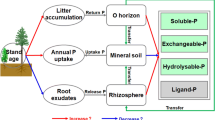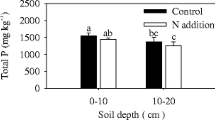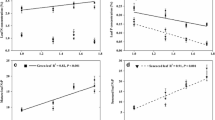Abstract
Background and aims
Soil phosphorus (P) can often regulate plant productivity. However, the medium- to long-term effects of reforestation on P cycle within the continuum of plant, litter, and soil (including deep soil layers), and the subsequent regulation of soil P storage and its fractions, remain unclear.
Methods
We determined soil (0–100 cm) P fractions, acid phosphatase, stoichiometric ratios, root and leaf N/P ratios, leaf P resorption efficiency (PRE), and leaf-litter P concentration of 32-, 45-, and 60-year-old Pinus massoniana reforestation in southwest China.
Results
The storage of soil labile, moderately labile, and occluded P decreased with the increase of stand age. The concentration of NaHCO3-Pi, NaHCO3-Po, and total labile P in top-soil layers decreased with the increase of stand age. The concentration of NaOH-Po and total moderately labile P in the entire soil profile declined over time. The concentration of C.HCl-Pi and total occluded P in the 0–100 cm soil layer were lower in the 60-year-old stand than in the 32-year-old stand. The PRE, leaf N/P ratio, top-soil C/P ratio and acid phosphatase activity increased, and the leaf-litter P concentration decreased with the increase of stand age.
Conclusions
P. massoniana trees secreted more acid phosphatase and increased PRE to compensate for the decrease in soil P availability with stand development, which in turn decreased leaf-litter P concentration and thus resulted in a depletion of soil P. Overall, our results highlighted that P limitation of P. massoniana reforestation increased with stand development.







Similar content being viewed by others
References
Allen SE, Grimshaw HM, Parkinson JA, Quarmby C (1974) Chemical analysis of ecological materials. Blackwell Scientific Publications, Oxford
Bai Y, Zhou Y, Chen X, An Z, Zhang X, Du J, Chang SX (2023) Tree species composition alters the decomposition of mixed litter and the associated microbial community composition and function in subtropical plantations in China. For Ecol Manag 529:120743. https://doi.org/10.1016/j.foreco.2022.120743
Barbieri P, MacDonald GK, Bernard de Raymond A, Nesme T (2021) Food system resilience to phosphorus shortages on a telecoupled planet. Nature Sustain 5(2):114–122. https://doi.org/10.1038/s41893-021-00816-1
Brandtberg PO, Davis MR, Clinton PW, Condron LM, Allen RB (2010) Forms of soil phosphorus affected by stand development of mountain beech (Nothofagus) forests in New Zealand. Geoderma 157(3–4):228–234. https://doi.org/10.1016/j.geoderma.2010.04.022
Celi L, Cerli C, Turner BL, Santoni S, Bonifacio E (2013) Biogeochemical cycling of soil phosphorus during natural revegetation of Pinus sylvestris on disused sand quarries in northwestern Russia. Plant Soil 367(1–2):121–134. https://doi.org/10.1007/s11104-013-1627-y
Chen CR, Hou EQ, Condron LM, Bacon G, Esfandbod M, Olley J, Turner BL (2015) Soil phosphorus fractionation and nutrient dynamics along the Cooloola coastal dune chronosequence, southern Queensland, Australia. Geoderma 257:4–13. https://doi.org/10.1016/j.geoderma.2015.04.027
Chen HY, Quan WX, Liu HY, Ding GJ (2022a) Effects of Suillus luteus and S. Bovinus on the physiological response and nutrient absorption of Pinus massoniana seedlings under phosphorus deficiency. Plant Soil 471(1–2):577–590. https://doi.org/10.1007/s11104-021-05211-5
Chen X, Chen HYH, Chang SX (2022b) Meta-analysis shows that plant mixtures increase soil phosphorus availability and plant productivity in diverse ecosystems. Nat Ecol Evol 6(8):1112–1121. https://doi.org/10.1038/s41559-022-01794-z
Cheng RM, Wang RL, Xiao WF, Feng XH, Liu ZB, Ge XG, Wang XR, Y, Z.W. (2012) Spatial distribution of root biomass of Pinus massoniana plantation in three gorges reservoir area, China (abstract in English). Acta Ecol Sin 32(3):823–832. https://doi.org/10.5846/stxb201104280561
Cleveland CC, Schmidt TSK (2002) Phosphorus limitation of microbial processes in moist tropical forests: evidence from short-term laboratory incubations and field studies. Ecosystems 5:680–691. https://doi.org/10.1007/s10021-002-0202-9
Du E, Terrer C, Pellegrini AFA, Ahlstrom A, van Lissa CJ, Zhao X, Xia N, Wu XH, Jackson RB (2020) Global patterns of terrestrial nitrogen and phosphorus limitation. Nat Geosci 13(3):221–226. https://doi.org/10.1038/s41561-019-0530-4
Ellsworth DS, Crous KY, De Kauwe MG, Verryckt LT, Goll D, Zaehle S, Bloomfield KJ, Ciais P, Cernusak LA, Domingues TF, Dusenge ME, Garcia S, Guerrieri R, Ishida FY, Janssens IA, Kenzo T, Ichie T, Medlyn BE, Meir P et al (2022) Convergence in phosphorus constraints to photosynthesis in forests around the world. Nat Commun 13(1):5005. https://doi.org/10.1038/s41467-022-32545-0
Elser JJ, Fagan WF, Kerkhoff AJ, Swenson NG, Enquist BJ (2010) Biological stoichiometry of plant production: metabolism, scaling and ecological response to global change. New Phytol 186(3):593–608. https://doi.org/10.1111/j.1469-8137.2010.03214.x
Fang J, Chen A, Peng C, Zhao S, Ci L (2001) Changes in forest biomass carbon storage in China between 1949 and 1998. Science 292(5525):2320–2322. https://doi.org/10.1126/science.1058629
Feng J, Song Y, Zhu B (2023) Ecosystem-dependent responses of soil carbon storage to phosphorus enrichment. New Phytol 238:2363–2374. https://doi.org/10.1111/nph.18907
Francos M, Vieira A, Bento-Gonçalves A, Úbeda X, Zema DA, Lucas-Borja ME (2023) Effects of wildfire, torrential rainfall and straw mulching on the physicochemical soil properties in a Mediterranean forest. Ecol Eng 192:106987. https://doi.org/10.1016/j.ecoleng.2023.106987
Garcia-Montiel DC, Neill C, Melillo J, Thomas S, Steudler PA, Cerri CC (2000) Soil phosphorus transformations following forest clearing for pasture in the Brazilian Amazon. Soil Sci Soc Am J 64(5):1792–1804. https://doi.org/10.2136/sssaj2000.6451792x
He X, Augusto L, Goll DS, Ringeval B, Wang Y, Helfenstein J, Huang Y, Yu K, Wang Z, Yang Y, Hou E (2021) Global patterns and drivers of soil total phosphorus concentration. Earth System Science Data 13(12):5831–5846. https://doi.org/10.5194/essd-13-5831-2021
Hedley MJ, Stewart JWB, Chauhan BS (1982) Changes in inorganic and organic soil phosphorus fractions induced by cultivation practices and by laboratory incubations. Soil Sci Soc Am J 46:970–976. https://doi.org/10.2136/sssaj1982.03615995004600050017x
Henneron L, Balesdent J, Alvarez G, Barre P, Baudin F, Basile-Doelsch I, Cecillon L, Fernandez-Martinez A, Hatte C, Fontaine S (2022) Bioenergetic control of soil carbon dynamics across depth. Nat Commun 13(1):7676. https://doi.org/10.1038/s41467-022-34951-w
Huang W, Liu J, Wang YP, Zhou G, Han T, Li Y (2013) Increasing phosphorus limitation along three successional forests in southern China. Plant Soil 364(1):181–191. https://doi.org/10.1007/s11104-012-1355-8
Izquierdo JE, Houlton BZ, van Huysen TL (2013) Evidence for progressive phosphorus limitation over long-term ecosystem development: examination of a biogeochemical paradigm. Plant Soil 367(1–2):135–147. https://doi.org/10.1007/s11104-013-1683-3
Koerselman W, Meuleman AFM (1996) The vegetation N:P ratio: a new tool to detect the nature of nutrient limitation. J Appl Ecol 33:1441–1450. https://doi.org/10.2307/2404783
Langhans C, Beusen AHW, Mogollón JM, Bouwman AF (2021) Phosphorus for sustainable development goal target of doubling smallholder productivity. Nature Sustain 5(1):57–63. https://doi.org/10.1038/s41893-021-00794-4
Liu Y, Zhang G, Luo X, Hou E, Zheng M, Zhang L, He X, Shen W, Wen D (2021) Mycorrhizal fungi and phosphatase involvement in rhizosphere phosphorus transformations improves plant nutrition during subtropical forest succession. Soil Biol Biochem 153:108099. https://doi.org/10.1016/j.soilbio.2020.108099
Némery J, Garnier J (2016) The fate of phosphorus. Nat Geosci 9(5):343–344. https://doi.org/10.1038/ngeo2702
Pan JW, Guo QQ, Li HE, Luo SQ, Zhang YQ, Yao S, Fan X, Sun XG, Qi YJ (2021) Dynamics of soil nutrients, microbial community structure, enzymatic activity, and their relationships along a chronosequence of Pinus massoniana plantations. Forests 12(3):376. https://doi.org/10.3390/f12030376
Peng S, Piao S, Zeng Z, Ciais P, Zhou L, Li LZX, Myneni RB, Yin Y, Zeng H (2014) Afforestation in China cools local land surface temperature. Proc Natl Acad Sci USA 111(8):2915–2919. https://doi.org/10.1073/pnas.1315126111
Peng ZY, Wu YT, Guo LL, Yang L, Wang B, Wang X, Liu WX, Su YJ, Wu J, Liu LL (2023) Foliar nutrient resorption stoichiometry and microbial phosphatase catalytic efficiency together alleviate the relative phosphorus limitation in forest ecosystems. New Phytol 238(3):1033–1044. https://doi.org/10.1111/nph.18797
Peñuelas J, Sardans J (2022) The global nitrogen-phosphorus imbalance. Science 375(6578):266–267. https://doi.org/10.1126/science.abl4827
Peñuelas J, Sardans J, Llusia J, Owen SM, Niinemets U (2011) Lower P contents and more widespread terpene presence in old Bornean than in young Hawaiian tropical plant species guilds. Ecosphere 2(4):1–19. https://doi.org/10.1890/es10-00185.1
Peñuelas J, Janssens IA, Ciais P, Obersteiner M, Sardans J (2020) Anthropogenic global shifts in biospheric N and P concentrations and ratios and their impacts on biodiversity, ecosystem productivity, food security, and human health. Glob Chang Biol 26:1962–1985. https://doi.org/10.1111/gcb.14981
Richardson SJ, Allen RB, Doherty JE (2008) Shifts in leaf N:P ratio during resorption reflect soil P in temperate rainforest. Funct Ecol 22(4):738–745. https://doi.org/10.1111/j.1365-2435.2008.01426.x
Sardans J, Janssens IA, Ciais P, Obersteiner M, Penuelas J (2021) Recent advances and future research in ecological stoichiometry. Perspect Plant Ecol Evol Syst 50:125611. https://doi.org/10.1016/j.ppees.2021.125611
Schinner F, Ohlinger R, Kandeler E, Margesin R (1996) Methods in soil biology. Springer-Verlag, Berlin
Selmants PC, Hart SC (2010) Phosphorus and soil development: does the Walker and Syers model apply to semiarid ecosystems? Ecology 91(2):474–484. https://doi.org/10.1890/09-0243.1
Shang R, Chen JM, Xu M, Lin X, Li P, Yu G, He N, Xu L, Gong P, Liu L, Liu H, Jiao W (2023) China’s current forest age structure will lead to weakened carbon sinks in the near future. Innovation 4(6). https://doi.org/10.1016/j.xinn.2023.100515
Shilenkova OL, Tiunov AV (2013) Soil–litter nitrogen transfer and changes in δ13C and δ15N values in decomposing leaf litter during laboratory incubation. Pedobiologia 56(3):147–152. https://doi.org/10.1016/j.pedobi.2013.03.004
Strukelj M, Brais S, Mazerolle MJ, Paré D, Drapeau P (2017) Decomposition patterns of foliar litter and deadwood in managed and unmanaged stands: a 13-year experiment in boreal mixedwoods. Ecosystems 21(1):68–84. https://doi.org/10.1007/s10021-017-0135-y
Sui Y, Thompson ML, Shang C (1999) Fractionation of phosphorus in a mollisol amended with biosolids. Soil Sci Soc Am J 63(5):1174–1180. https://doi.org/10.2136/sssaj1999.6351174x
Tabatabai MA (1982) Soil enzymes. In: Weaver R, Angle S, Bottomley P, Bezdicek D, Smith S, Tabatabai M, Wollum A (eds) Methods of soil analysis. Soil Science Society of America, Madison
Tie L, Wei S, Peñuelas J, Sardans J, Liu X, Zhou S, Liu X, Bose AK, Huang C (2023) N and P combined addition accelerates the release of litter C, N, and most metal nutrients in a N-rich subtropical forest. Sci Total Environ 881:163491. https://doi.org/10.1016/j.scitotenv.2023.163491
Tiessen H, Moir JO (2008) Soil sampling and methods of analysis (second edition). CRC Press, Boca Raton
Tong X, Brandt M, Yue Y, Ciais P, Jepsen MR, Penuelas J, Wigneron J-P, Xiao X, Song X-P, Horion S, Rasmussen K, Saatchi S, Fan L, Wang K, Zhang B, Chen Z, Wang Y, Li X, Fensholt R (2020) Forest management in southern China generates short term extensive carbon sequestration. Nat Commun 11(1):129. https://doi.org/10.1038/s41467-019-13798-8
Tonini D, Saveyn HGM, Huygens D (2019) Environmental and health co-benefits for advanced phosphorus recovery. Nature Sustain 2(11):1051–1061. https://doi.org/10.1038/s41893-019-0416-x
Turner BL, Brenes-Arguedas T, Condit R (2018) Pervasive phosphorus limitation of tree species but not communities in tropical forests. Nature 555(7696):367–370. https://doi.org/10.1038/nature25789
Vallicrosa H, Lugli LF, Fuchslueger L, Sardans J, Ramirez-Rojas I, Verbruggen E, Grau O, Brechet L, Peguero G, Van Langenhove L, Verryckt LT, Terrer C, Llusia J, Ogaya R, Marquez L, Roc-Fernandez P, Janssens I, Peñuelas J (2023) Phosphorus scarcity contributes to nitrogen limitation in lowland tropical rainforests. Ecology:e4049. https://doi.org/10.1002/ecy.4049
Vincent AG, Vestergren J, Gröbner G, Persson P, Schleucher J, Giesler R (2013) Soil organic phosphorus transformations in a boreal forest chronosequence. Plant Soil 367(1–2):149–162. https://doi.org/10.1007/s11104-013-1731-z
Vu DT, Tang C, Armstrong RD (2007) Changes and availability of P fractions following 65 years of P application to a calcareous soil in a Mediterranean climate. Plant Soil 304(1–2):21–33. https://doi.org/10.1007/s11104-007-9516-x
Wieder WR, Cleveland CC, Smith WK, Todd-Brown K (2015) Future productivity and carbon storage limited by terrestrial nutrient availability. Nat Geosci 8(6):441–444. https://doi.org/10.1038/ngeo2413
Withers PJA (2019) Closing the phosphorus cycle. Nature Sustain 2(11):1001–1002. https://doi.org/10.1038/s41893-019-0428-6
WRB, IWG (2015) World Reference Base for Soil Resources 2014, update 2015. International soil classification system for naming soils and creating legends for soil maps. World Soil Resources Reports, No. 106. FAO, Rome
Yang SB, Feng C, Ma YH, Wang WJ, Huang C, Qi CJ, Fu SL, Chen HYH (2021) Transition from N to P limited soil nutrients over time since restoration in degraded subtropical broadleaved mixed forests. For Ecol Manag 494:119298. https://doi.org/10.1016/j.foreco.2021.119298
Yu Z, Ciais P, Piao S, Houghton RA, Lu C, Tian H, Agathokleous E, Kattel GR, Sitch S, Goll D, Yue X, Walker A, Friedlingstein P, Jain AK, Liu S, Zhou G (2022) Forest expansion dominates China's land carbon sink since 1980. Nat Commun 13(1):5374. https://doi.org/10.1038/s41467-022-32961-2
Yuan ZY, Chen HYH (2015) Negative effects of fertilization on plant nutrient resorption. Ecology 96(2):373–380. https://doi.org/10.1890/14-0140.1
Zhang Y, Guo Y, Tang Z, Feng Y, Zhu X, Xu W, Bai Y, Zhou G, Xie Z, Fang J (2021a) Patterns of nitrogen and phosphorus pools in terrestrial ecosystems in China. Earth System Science Data 13(11):5337–5351. https://doi.org/10.5194/essd-2020-398
Zhang YL, Li Y, Wang SZ, Umbreen S, Zhou CF (2021b) Soil phosphorus fractionation and its association with soil phosphate-solubilizing bacteria in a chronosequence of vegetation restoration. Ecol Eng 164:106208. https://doi.org/10.1016/j.ecoleng.2021.106208
Zhu J, Wang Q, He N, Melinda SD, Elser JJ, Du J, Yuan G, Yu G, Yu Q (2016) Imbalanced atmospheric nitrogen and phosphorus depositions in China: implications for nutrient limitation. J Geophys Res: Biogeosci 121(6):1605–1616. https://doi.org/10.1002/2016JG00339
Zhu X, Fang X, Wang L, Xiang W, Alharbi HA, Lei P, Kuzyakov Y (2021) Regulation of soil phosphorus availability and composition during forest succession in subtropics. For Ecol Manag 502:119706. https://doi.org/10.1016/j.foreco.2021.119706
Acknowledgments
This work was supported by the Guizhou Provincial Basic Research Program (ZK[2022]YIBAN101; ZK[2023]YIBAN110), National Natural Science Foundation of China (32360259), and Natural Science Project of Guizhou University [202131]. Josep Peñuelas and Jordi Sardans are financially supported by the Fundación Ramon Areces grant CIVP20A6621, the Spanish Government grants PID2020115770RB-I, TED2021-132627B-I00 and PID2022-140808NB-I00 funded by MCIN, AEI/https://doi.org/10.13039/501100011033 European Union Next Generation EU/PRTR, and the Catalan Government Grant SGR2021-1333. We thank Xiaojin Wang, Wenting Tang, Xianyan Wang, Li Zhang, Maiwei Yang for their contributions to the laboratory.
Author information
Authors and Affiliations
Contributions
Liehua Tie: Methodology, Formal analysis, Writing - original draft, Writing - review & editing. Josep Peñuelas: Conceptualization, Results discussion, Writing - original draft, Writing - review & editing. Congde Huang: Writing - original draft, Writing - review & editing. Jordi Sardans: Writing - original draft, Writing - review & editing. Arun K. Bose: Writing - original draft, Writing - review & editing. Shengnan Ouyang: Methodology, Writing - review & editing. Yixian Kong: Methodology, Resources. Yan Guo: Methodology, Resources. Yujie Wu: Methodology, Resources. Wei Cheng: Methodology, Resources. Guijie Ding: Methodology, Writing - review & editing.
Corresponding author
Ethics declarations
Competing interests
The authors declare that they have no competing financial interests.
Additional information
Responsible Editor: Hans Lambers.
Publisher’s Note
Springer Nature remains neutral with regard to jurisdictional claims in published maps and institutional affiliations.
Supplementary Information
ESM 1
(DOCX 68223 kb)
Rights and permissions
Springer Nature or its licensor (e.g. a society or other partner) holds exclusive rights to this article under a publishing agreement with the author(s) or other rightsholder(s); author self-archiving of the accepted manuscript version of this article is solely governed by the terms of such publishing agreement and applicable law.
About this article
Cite this article
Tie, L., Peñuelas, J., Huang, C. et al. Phosphorus limitation of Pinus massoniana reforestation increases with stand development: evidence from plant, leaf litter, and soil. Plant Soil (2024). https://doi.org/10.1007/s11104-024-06661-3
Received:
Accepted:
Published:
DOI: https://doi.org/10.1007/s11104-024-06661-3




